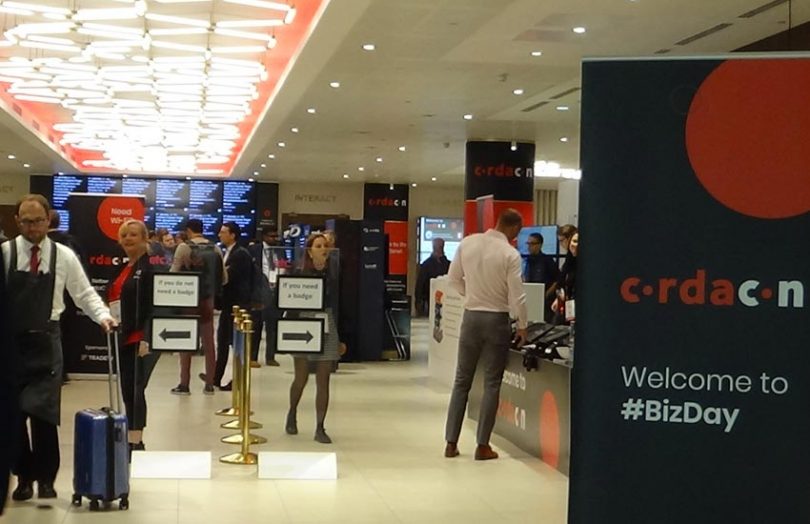The takeaway from last week’s CordaCon conference was the number of significant enterprise blockchain consortia preparing to go live. R3’s Chairman Frédéric Dalibard noted that the conversation has changed from experimentation to “how do I put my CorDapp into production, and how to iron out the legal details,” he said. “Which means this is real.”
The event almost doubled in size since last year with 2,000 attendees.
While R3 is seeing its Corda blockchain adopted beyond finance, the big consortia currently readying for launch are in insurance, trade finance and capital markets.
Central bank cash on ledger
In the latter case, having central bank cash on the ledger bolsters the ability to deliver low-risk instant settlement finality. And it was the subject of one of the most significant announcements at the conference. Accenture and SAP unveiled a Corda prototype for real-time gross settlement (RTGS) systems.
Accenture’s John Velissarios described it as “another payment channel for central banks. And the idea behind this is to use tokens for settlement purposes.” He also credited R3 for its role in the project.
The solution will run alongside existing RTGS systems enabling tokenized payments to be received as regular payments by a non-participating bank. The distributed ledger technology (DLT) aspect is integrated with SAP’s existing RTGS platform SAP Payment Engine.
SAP’s Peter Bramm revealed that the purpose isn’t purely to enable tokenization. The aim is also to mitigate the risk of RTGS systems being single points of failure. Bramm noted that “the DLT runs alongside the RTGS and can execute transactions even when the RTGS is down.”
But for the blockchain ecosystem, the major benefit is the potential for exchanges to tokenize cash.
R3’s initial sweetspot: capital markets
Separately, in early October Swiss exchange SIX announced it’s working with the Swiss National Bank to integrate central bank money into the Swiss Digital Exchange which will tokenize a variety of assets.
Sven Roth from SIX spoke about a Proof of Concept in which banks wire money from their accounts at the central bank to SIX’s omnibus account. The cash is then tokenized on the ledger and distributed to the respective bank nodes.
But the more recent announcement went a step further and will explore putting central bank cash on the ledger, as opposed tokenized money from SIX’s account at the central bank.
“If you have a smart asset that is a tokenized asset only living on the DLT, and you have smart fiat tokens, smart cash, that is kind of the perfect world to create smart solutions,” said Roth.
While SIX has delayed its go-live until next year, Deutsche Boerse and HQLAX are getting ready to launch their collateral management platform with a handful of clients next month. That smaller number is just a fraction of the more than 20 major banks which are at different stages of onboarding to HQLAX.
The Deutsche Boerse’s Jens Hachmeister highlighted the need for a DLT solution to add value. It has to be “faster, cheaper, less risky, or less clunky, so more straight through. If you are not able to tick these boxes, you will have a hard time getting a community of potential users behind your business idea.”
Applying that to HQLAX, Hachmeister said: “it’s reducing risk, it’s reducing the costs of over-collateralization.”
HQLAX‘s CEO Guido Stroemer and Hachmeister both touched on the issue of regulation. “Rather than trying to change regulations and the legal constructs to fit the technology, we fit the technology to meet the existing regs and legal constructs,” said Stroemer. “Building the tech was probably the easier part of that equation. Synchronizing the legal and regs to match the tech took a lot more resourcing and time quite frankly.”
Insurance blockchains get going
Turning to insurance, B3i which is owned by 18 global insurers went into production on the Corda network at the end of July with its initial product for reinsurance. The first wave of live transactions is planned for the January 1st reinsurance renewal cycle.
R3 is pretty dominant in the insurance sector with U.S. headquartered RiskStream also using Corda. The consortium has global aims, boasts 38 members and has just started production testing its Canopy platform. Its first solution is the initial notification of auto claims. RiskStream’s leader, Christopher McDaniel, told Ledger Insights that it’s planning for a handful of insurers to run in parallel to live systems in the first quarter of 2020.
Interoperability
Of particular relevance to the insurance sector is interoperability, which was the second theme of the conference after go-live. That’s because insurers may want to provide cover for transactions in other networks, such as trade or trade finance.
Both of the insurance groups lead the DLT working group at insurance standards body ACORD.
According to Nationwide’s Mike Fulton interoperability is “about the flow of data between applications. It’s about the flow of data between enterprises. It’s about the flow of data now in contexts like this, between industries, between platforms and enabling that flow of data to work with absolute security but minimal effort for all the parties involved.”
Another sector where interoperability is particularly important is trade finance. At last year’s CordaCon, the Universal Trade Network (UTN) was unveiled to encourage standards and interoperability across sectors and technologies. A few weeks ago at Sibos, R3’s Alicia Dicaprio revealed that the initiative had been taken on by the International Chamber of Commerce (ICC).
Marco Polo is live
The UTN was initiated by R3 and TradeIX, the technology company behind the Marco Polo trade finance network. The latter group currently is comprised of 23 plus major institutions, larger than the other international consortia. At the conference, it was confirmed that the Marco Polo network quietly went live earlier this month. Like B3i, which is in production, none of the banks are live yet, and each bank will onboard in its own time.
The other big Corda trade finance initiative is the Letter of Credit network formerly called Voltron. It’s in the process of changing its name and incorporating and will also launch in the not-too-distant future.
Even though this seems like a shopping list of initiatives, it only scratches the surface. For example, Mastercard is interconnecting domestic faster payments services for cross border payments. And Finastra’s Fusion LenderComm is digitizing syndicated loans and was the first dApp to go live on Corda.
Plus R3 has several initiatives to shore up an ever-expanding startup community using its platform. At the event, it was announced that San Fransisco startup TrustLayer won the inaugural insurtech challenge, beating 63 applicants.
The tone of the conference was upbeat. In fact, Ledger Insights recently chose not to publish an article because the interviews with multiple R3 clients were so effusive that it sounded like a promotional piece.
Talking about the energy from the conference attendees, R3’s CEO David Rutter noted “some of you charge me up because it’s almost like a Corda religion sometimes.”







